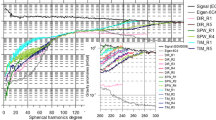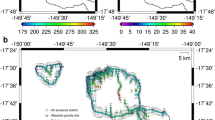Abstract
The accumulation of good quality satellite altimetry missions allows us to have a precise geoid with fair resolution and to compute free air gravity anomalies easily by fast Fourier transform (FFT) techniques.
In this study we are comparing two methods to get gravity anomalies. The first one is to establish a geoid grid and transform it into anomalies using inverse Stokes formula in the spectral domain via FFT. The second one computes deflection of the vertical grids and transforms them into anomalies.
The comparison is made using different data sets: Geosat, ERS-1 and Topex-Poseidon exact repeat misions (ERMs) north of 30°S and Geosat geodetic mission (GM) south of 30°S. The second method which transforms the geoid gradients converted into deflection of the vertical values is much better and the results have been favourably evaluated by comparison with marine gravity data.
Similar content being viewed by others
References
Akima, H. (1970) A new method of interpolation and smooth curve fitting based on local procedures, J. of the Assoc.for Computing Machinery, Vol.17, No.4, pp.589–602.
Balmino, G. (1992) Orbit choice and the theory of radial orbit error for altimetry, in Satellite Altimetry in Geodesy and Oceanography, R. Rummel and F. Sanso (Eds), Springer-Verlag, 243–315.
Farelly, B. (1991) The geodetic approximations in the conversion of geoid height to gravity anomaly by Fourier transform, Bull. Géodésique, 65:92–101.
Forsberg, R. and D. Solheim (1988) Performance of FFT methods in local gravity field modelling, Chapman Conference on progress in the determination of the Earth's gravity field, pp. 100–103.
Forsberg, R. and M.G. Sideris (1993) Geoid computations by the multi-band spherical FFT approach, Manuscripta Geodaetica, Vol. 18, No. 2, pp. 82–90.
Haxby, W.F., Karner G.D., Labrecque J.L. and Weissel J.K. (1983) Digital images of combined oceanic and continental data sets and their use in tectonic studies. EOS Trans. Am. geophys. Un., 64, pp. 995–1004.
Knudsen, P., O.B. Andersen and C.C. Tscherning (1992) Altimetric gravity anomalies in the Norwegian-Greenland Sea — Preliminary results from the ERS-1 35 days repeat mission, Geophys. Res. Lett., Vol. 19, No. 17, pp. 1795–1798.
Levitus, S. (1982) Climatological Atlas of the World Ocean NOAA, Geophysical Fluid Dynamics Laboratory, Professional Paper 13, Rockville, MD.
Neumann, G.A., D.W. Forsyth and D.T. Sandwell (1993) Comparison of marine gravity from shipboard and highdensity satellite altimetry along the Mid-Atlantic Ridge, Geophys. Res. Lett., Vol. 20, No. 15, pp. 1639–1642.
Rapp, R.H. and T. Basic (1992) Oceanwide gravity anomalies from Geos-3, Seasat and Geosat altimeter data, Geophys. Res. Lett., Vol. 19, No. 19, pp. 1979–1982.
Rapp, R.H., Y.M. Wang and N.K. Pavlis (1991) The Ohio State 1991 geopotential and sea surface topography harmonic coefficient models, Rep. 410, Dep. of Geod. Sci. and Surv., The Ohio State Univ., Columbus.
Sandwell, D.T. (1987) Biharmonic spline interpolation of Geos-3 and Seasat altimeter data, Geophys. Res.Lett., Vol. 14, No. 2, pp. 139–142.
Sandwell, D.T. (1992) Antartic marine gravity field from high-density satellite altimetry, Geophys. J. Int. 109, 437–448.
Sandwell, D.T. and W.H.F. Smith (1992) Global marine gravity from ERS-1, Geosat and Seasat reveals new tectonic fabric, AGU Fall meeting, G42D-7.
Schwarz, K.P., M.G. Sideris and R. Forsberg (1990) The use of FFT techniques in physical geodesy, Geophys. J. Int 100, 485–514.
Sharman, G.F. and D. Metzger (1994) National Geophysical Data Center's GEODAS CD-ROM Project, submitted to Bulletin d'information, Bureau Gravimétrique International.
Smith, W.H.F. and P. Wessel (1990) Gridding with continuous curvature splines in tension, Geophysics, Vol. 55, pp. 293–305.
Strang van Hees, G. (1990) Stokes formula using Fast Fourier Techniques, Manuscripta Geodaetica, Vol. 15, pp. 235–239.
Wang, Y.M. and R.H. Rapp (1992) The determination of a one year mean sea surface height track from Geosat altimeter data and ocean variability implications, Bull. Géodésique, 66:336–345.
Author information
Authors and Affiliations
Rights and permissions
About this article
Cite this article
Olgiati, A., Balmino, G., Sarrailh, M. et al. Gravity anomalies from satellite altimetry: comparison between computation via geoid heights and via deflections of the vertical. Bulletin Géodésique 69, 252–260 (1995). https://doi.org/10.1007/BF00806737
Received:
Accepted:
Issue Date:
DOI: https://doi.org/10.1007/BF00806737




